Chess is different than most other sports. A draw, not a win, is the most common result of a chess game and may even win you championships. Imagine a sporting event, in which the visiting team gets more chances to score, but when time expires and the score is tied, the championship trophy goes to a home team. Something similar happened Tuesday at this year's U.S. Championship at the Chess Club and Scholastic Center in St. Louis.
In a dramatic single playoff game, GM Gata Kamsky displayed great defensive skills and won the U.S. title by drawing with the black pieces. His opponent, GM Yuri Shulman, had more time for the game, but according to the rules had to win with the white pieces. He was close, but missed several chances, allowing Kamsky to escape. "Gata had nine lives," said Shulman, expressing his frustration after the championship game.
The championship's new hybrid format was confusing, but it led to fighting chess. The $173,000 event began with seven Swiss rounds to determine four out of 24 players for the round-robin Final. It worked perfectly as the top three rated players and pre-tournament favorites, the defending U.S. champion GM Hikaru Nakamura, former world championship challenger Gata Kamsky and former U.S. champion GM Alexander Onischuk, qualified and were joined by the 2008 titleholder Yuri Shulman. Each grandmaster scored three wins, four draws and no losses.
Last Sunday was decisive in the Final Four. Onischuk turned down a draw offer and lost to Kamsky. Shulman eliminated Nakamura. It set the stage for the Kamsky-Shulman confrontation. They drew their regular game on Monday and Kamsky won the title and the $30,000 first prize the next day in the playoff.
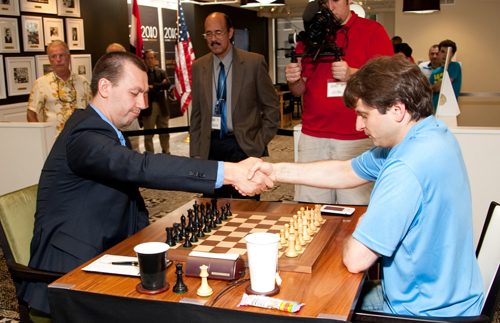
I chose two games from the U.S. Chess Championship that have a common theme. First, both winners did something chess beginners are warned not to do: they brought their Queens out too early. Secondly, through a well thought-out positional strategy, the conquerors acquired control of the light squares and staged decisive mating attacks.
The veteran grandmaster Larry Christiansen, 53, is an attacking chess wizard who does not mind to shed material as long as he is having fun menacing his opponent's King. He strives in complicated positions and his imaginative play brought him many victories and also saved him from trouble. Gata Kamsky made a strong psychological move; he turned the tables around and played like Christiansen, sacrificing pawns and attacking relentlessly. Forced to his knees from the onset, Christiansen was unable to strike back. Played in the fifth round, it was Kamsky's best game overall.
Kamsky - Christiansen
Spanish Opening, The Classical variation
U.S. Championship, Saint Louis 2010
1.e4 e5 2.Nf3 Nc6 3.Bb5 (The powerful Spanish Opening is more than 500 years old. It is often associated with Ruy Lopez, a priest who served at the court of the Spanish king, Philip II, and analyzed it in his book in 1561. But it already appeared in the oldest surviving chess book, "Repeticion de amores e arte de axedrez con cliuegos de partido," written by another Spaniard, Luiz Ramirez Lucena, in 1497.) 3...Bc5 (The Classical variation, favored by many champions and world-class players. Adolf Anderssen, Paul Morphy and William Steinitz played it in the 19th century. Jose Raul Capablanca, Alexander Alekhine, Boris Spassky, Bobby Fischer, and more recently Vishy Anand and Veselin Topalov also tried it. Even Kamsky used it with the black pieces.) 4.0-0 Nd4 (The psychological warfare begins. Christiansen goes for a less frequented road, avoiding the queen exchange, more or less forced after 4...Nf6 5.Nxe5 Nxe5 6.d4 Nxe4 7.Qe2 Qe7 8.Qxe4 Nc6 9.Qxe7+ Bxe7 10.c3 and white gets more space and a slightly better endgame. Kamsky, a feared, brilliant endgame technician, would love that.) 5.Ba4 (5.Nxd4 is played more often, but after 5...Bxd4 6.c3 Bb6 7.d4 c6 8.Ba4 d6 Black has good chances to equalize.) 5...Nxf3+ 6.Qxf3 Ne7 (Christiansen strives for a good counterplay, not blocking his f-pawn. After 6...Nf6 7.d3 0-0 8.Nc3 white has a better grip in the center. Offering a queen exchange 6...Qf6 is a good alternative.)
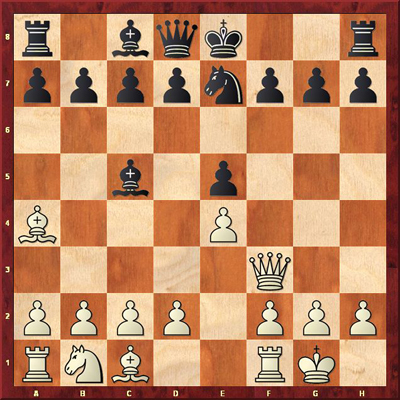
7.Qc3! (An aggressive Queen-shuffling maneuver. White lures the black bishop to d4, where it can be soon attacked. It allows Kamsky to build a pawn center quickly. Slower, steady developing moves may not do the job. For example, in the game Reti-Spielmann, Budapest 1913, White came under a furious attack after 7.d3 0-0 8.Be3 Bb6 9.Nc3 d6 10.Rad1 f5! 11.Qh5 f4 12.Bxb6 axb6 13.Bb3+ Kh8 14.d4 Ng6 15.Rd2 f3 16.g3 Nf4! 17.gxf4 Rxf4 and resigned since after 18. h3 [defending against the threat 18...Bg4 to win the queen] 18...g6 19.Qh6 Rh4 20.Qe3 Rxh3 black has a mating attack.) 7...Bd4 8.Qg3 Ng6 9.c3 Bb6 10.d4!? (A daring pawn sacrifice. White has to act quickly to dominate the center, bring more pieces into play and put pressure on Black.) 10...0-0 (It is safe to assume that after 10...exd4 Kamsky was going to continue with 11.f4!? as in the game, when the attempt to exchange the Queens with 11...Qh4 fails to 12.Qxh4 Nxh4 13.f5!, threatening to win the knight with 14.g3.) 11.f4!? (Kamsky continues to play sharply. He did not bother calculating 11.dxe5 Qe7 12.Bf4 d6! and Black wins the pawn back since after 13.ed6? Qxe4 White loses a piece.)
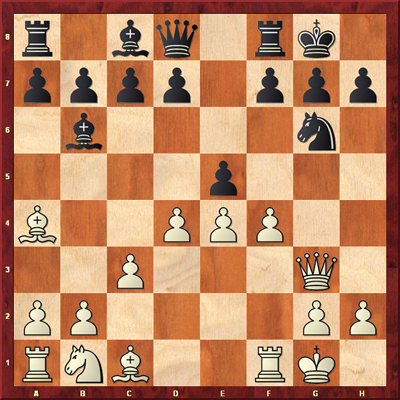
11...exf4?! (Leaving White with a strong pawn center. Accepting the pawn with 11...exd4 is unclear, but worth a try. After 12.f5!? White has a good compensation either after 12...dxc3+ 13.Kh1 Bd4 14.Nxc3 Be5 15.Qf2 Ne7 16.Bf4; or after 12...Qf6 13.Kh1 h6 14.cxd4 Bxd4 15.Nc3.) 12.Bxf4 Nxf4 13.Qxf4 d6 14.Nd2 Be6 15.Kh1 c6 16.Nf3 h6 (Defending against 17.Ng5, but the move weakens the diagonal b1-h7 and Kamsky finds a way to open it up.) 17.Bc2 Qd7 18.e5!? dxe5?! (Christiansen reacts nervously, surrendering a nice square on e5. But after 18...d5 19.Nh4 the white pieces swarm the black King, for example 19...g5? 20.Qf6! gxh4 21.Qxh6 f5 22.exf6 Bc7 23.Qg6+ Kh8 24.Rf5! Bxf5 25.Bxf5 Qf7 26.Qh6+ Kg8 27.Be6 Qxe6 28.Qg7 mate; or 19...c5 20.Qg3 cxd4 21.Qd3 f5 22.g4! with a powerful attack. Also after18...Bc7 19.Qe4 g6 20.Qf4 Kg7 21.Rae1 white has a strong pull.) 19.Nxe5 Qd6 20.Qg3 f5?! (A radical solution to slow White's surge on the kingside, but it only pours more oil on the fire. Either 20...Rad8 or 20...Bc7 seem preferable.) 21.Rae1 Bc7 (After 21...Rad8 white has a pinning combination 22.Ng6! Qxg3 23.hxg3 Rf6 24.Rxe6! Rxe6 25.Bb3 and should win.) 22.Qh3! (Forcing the weakening of the diagonal b1-h7.) 22...f4 23.Qd3 Bf5 24.Bb3+ Kh7 25.Qd2 g5 (With a pawn chain resembling the King's Gambit, Christiansen hopes to survive. But Kamsky finds an ingenious way to storm Black's rampart.)
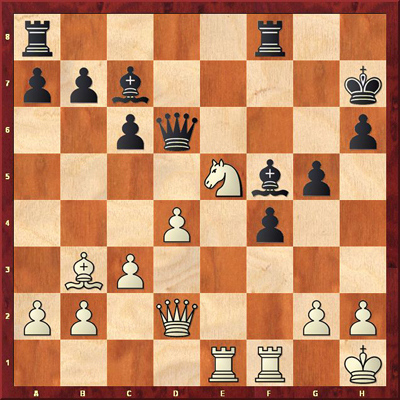
26.g4! (Winning the battle of the light squares.) 26...Bc8 (Not finding another suitable square, the Bishop slides back home. After 26...Bg6 27.Nxg6 Black loses his queen either after 27...Kxg6 28.Re6+ or after 27...Qxg6 28.Bc2. And 26...fxg3 is unplayable because of 27.Rxf5! Rxf5 28.Bc2 Raf8 29.Bxf5+ Rxf5 30.Qd3 Qe6 31.Rf1 winning material.) 27.Qd3+ Kg7 28.Bc2 (The battery of the Queen and Bishop on the diagonal b1-h7 is deadly.) 28...Rh8 29.Ng6! (Threatening both 30.Nxh8 and 30.Re7+.) 29...Bxg4 (Leads to a pretty finish, but Black didn't have many choices. After 29...Be6 30.Nxh8 Bd5+ 31.Kg1 Rxh8 32.Bb3 white should win anyway.) 30.Re7+ Kf6 (On 30...Kg8 31.Bb3+ wins.) 31.Rxc7 Rhg8 (After 31...Qxc7 32.Nxh8 Rxh8 33.Qg6+ Ke7 34.Qg7+ wins.) 32.Ne5 (After 32...Qxc7 33.Nxg4+ Ke7 34.Qh7+ Kd6 35.Qxh6+ Kd7 36.Bf5+ Kd8 37.Re1 wins.) Black resigned.
Hikaru Nakamura did not prepare well against Yuri Shulman's Winawer French and was thoroughly outplayed and eliminated from the title fight. I highlight this opening as a tribute to my friend Bill Hook, a wonderful artist and the kindest of men, who died this month at age 84. He played the top board for the British Virgin Islands team at 17 chess Olympiads. In 1970 in Siegen, Germany, Hook tried his beloved queen maneuver against Bobby Fischer and easily equalized the game. He would have turned 85 this Friday.
Nakamura - Shulman
French defense, Winawer variation
U.S. Championship, Saint Louis 2010
1.e4 e6 2.d4 d5 3.Nc3 Bb4 4.e5 c5 5.a3 Bxc3+ 6.bxc3 Qa5 7.Bd2 Qa4 (The Queen sortie was Bill Hook's specialty. Black wants to assume control of the light squares, playing b7-b6 and exchanging the bishops with Bc8-a6.) 8.Nf3 (Nakamura has in mind a pawn sacrifice invented by Garry Kasparov. Fischer tried 8.Qg4 Kf8 9.Qd1, but after 9...b6 10.h4 Ne7 11.h5 h6 12.Rh4 Ba6 13.Bxa6 Nxa6 14.Rf4 Qd7 Hook had a playable game. However, he spoiled it later and allowed Fischer to win in 28 moves.) 8...Nc6 9.h4 cxd4 10.cxd4 Nge7 11.h5!? Nxd4 12.Bd3 h6! (White's advance has to be stopped. In the game Kasparov-Anand, Linares 1992, Black's kingside was shattered after 12...Nec6?! 13.Kf1 Nxf3 14.Qxf3 b6 15.h6! Ba6 16.hxg7 Rg8 17.Bxa6 Qxa6+ 18.Kg1 Rxg7 19.Qf6 Rg8 20.Rxh7 Qb7 and now instead of 21.Bg5, White could have played 21.c4! with the idea 21...dxc4 22.Bg5 Qe7 23.Qf3! Qc7 24.Rd1 with a decisive pressure.) 13.Kf1 Nxf3 14.Qxf3 b6! 15.Qg3 (It seems that White has a powerful initiative, since the passive defense 15...Rg8 is met by 16.Rh4 d4 17.Rg4! and after 17...Kf8? 18.Rxg7! Rxg7 19.Bxh6 wins. But Shulman has a surprise up his sleeve.)
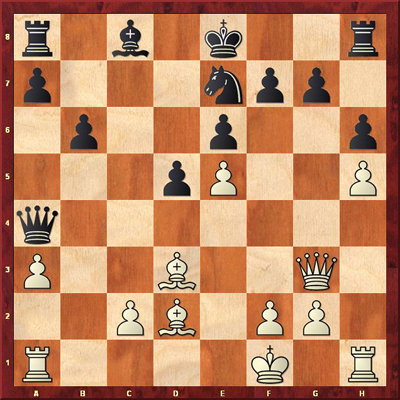
15...Ba6! (By sacrificing two pawns, Shulman gets rid of the light Bishops and begins to dictate the play.) 16.Qxg7 Bxd3+ 17.cxd3 Rg8 18.Qxh6 (After 18.Qh7 Qg4 19.g3 Rc8 all Black pieces are in harmony.) 18...Qd4 19.Re1?! (A new move, but playing the rook to the open c-file, as it was done previously, makes more sense. It is hard to believe that Hikaru prepared the variation up to this point. If he did, he misjudged it because Black has all the trumps.) 19...Qxd3+ 20.Kg1 Rc8 21.Bg5?! (White's best chance was to offer the Queen exchange 21.Qe3.) 21...Qf5 22.f4? (Fatally locking his Queen out of play. Nakamura had to try 22.Bxe7 Kxe7 23.Qe3, hoping to consolidate.) 22...Rc2 23.Rh2? (Loses. White becomes vulnerable on the first rank. 23.Qf6 Qxf6 24.exf6 Nf5 25.Rh3 was the last hope.) 23...Qd3! 24.Qf6 (Too late. Also after 24.Bxe7 Qd2! Black mates.)

24...Rxg5! (Eliminating the last menacing threat.) 25.Qxg5 (After 25.fxg5 Nf5, threatening 26...Qd4+ 27.Kh1 Ng3 mate, Black wins.) 25...Qd4+ 26.Kh1 Qe3! (A final blow. The Queen is tabu since 27.Rxe3 allows 27...Rc1+ and Black mates. And after 27.Qh4 Rc1 wins.) White resigned.
For a live replay:
Note that in the replay windows below you can click on the notation to
follow the game.
Images provided by Betsy Dynako and the Chess Club and Scholastic Center of Saint Louis. Lubomir Kavalek is the Huffington Post's chess correspondent.
